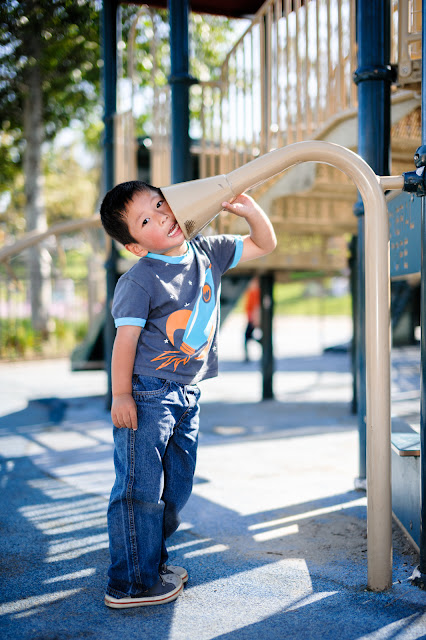
I like using bounce flash because it gives me soft and directional light when used with proper technique. Outdoors, however, bouncing flash is not so easy, particularly when it's bright and sunny. Those were the circumstances when I took the shot above. What flash technique did I use here (or did I not use flash at all)? Take a guess! What technique would you have used here?
Answer: I used direct on-camera flash with no modifiers. (cue the thunder and lightning)
When I first learned about lighting, one of the first things that was drilled into me was that direct on-camera flash is terrible. The light quality is hard (because of the small size of the speedlight), flat and unnatural (because the light is coming from the camera's direction). I've taken some extreme measures to use anything but direct on-camera flash, sometimes using a handheld umbrella to soften the light and control its direction.
When I first learned about lighting, one of the first things that was drilled into me was that direct on-camera flash is terrible. The light quality is hard (because of the small size of the speedlight), flat and unnatural (because the light is coming from the camera's direction). I've taken some extreme measures to use anything but direct on-camera flash, sometimes using a handheld umbrella to soften the light and control its direction.
However, there are times when using a direct on-camera flash is perfectly fine. One such instance is when you are outdoors and there's no place from which to bounce a flash.
In the shot above and the ones below, that's exactly what I did - I used an on-camera flash pointed directly forward, but in my opinion, the use of the flash is not obtrusive and improves the images.
In the shot above and the ones below, that's exactly what I did - I used an on-camera flash pointed directly forward, but in my opinion, the use of the flash is not obtrusive and improves the images.


You may be wondering: it's bright enough, so why use flash in the first place under these circumstances?
1. Shadow detail. When taking photos outdoors in bright sunlight, the sunlight often casts deep shadows. Using flash, we can illuminate those shadows to bring out relevant details that would otherwise be harder to see.
 |
| Without flash - faces in shadow |
 |
| With flash |
 |
| Without flash - washed out background |
 |
| With flash - more saturated background |
Some tips to make the best use of flash outdoors:
1. Be aware of the direction of the ambient light and use it as key or rim. It's still a good idea to use lighting techniques to show the subject's form. One way to do this when using direct on-camera flash to use ambient light as a key or rim light by carefully positioning the subject (or waiting for the subject to move into the right position).
2. Control the intensity of the flash and use it as fill. This is a corollary from the previous point. When flash is acting as fill, it has to have a lower intensity than the ambient light that is acting as key or rim. Otherwise, if they had the same intensity, the shaping effect of the ambient light will be negated. Moreover, if the fill is just as bright as the key (or rim), it makes the use of the flash more obvious.
To control the flash intensity with TTL flash, you decrease flash exposure compensation (sometimes though the system is smart enough to know that the flash is acting as fill and will therefore decrease the flash exposure automatically). See the TTL Flash Tutorial.
To control the flash intensity with TTL flash, you decrease flash exposure compensation (sometimes though the system is smart enough to know that the flash is acting as fill and will therefore decrease the flash exposure automatically). See the TTL Flash Tutorial.
3. To minimize shadows, avoid having the subject next to objects. One way the use of direct on-camera flash becomes obvious is when the subject casts shadows from the flash. First, the on-camera flash shadow doesn't have the same direction as the ambient light. Second, the flash direction is from the camera's axis (or close to it) which is an unnatural direction for light (you could try to create the sense of direct frontal light from sunset, but if that's your intent you should gel the flash).
4. Use an external flash. A popup flash is closer to the axis but is limited to the sync speed (thus requiring narrow apertures in bright conditions). Using an external flash allows high speed sync, which in turn allows you to use wide apertures for shallow depth of field. As an extra benefit, the use of flash becomes a little harder to detect because most people are less accustomed to seeing a shallow depth of field in flash-lit photos in bright conditions.
4. Use an external flash. A popup flash is closer to the axis but is limited to the sync speed (thus requiring narrow apertures in bright conditions). Using an external flash allows high speed sync, which in turn allows you to use wide apertures for shallow depth of field. As an extra benefit, the use of flash becomes a little harder to detect because most people are less accustomed to seeing a shallow depth of field in flash-lit photos in bright conditions.
5. Finally, one more way to disguise the use of flash is to clone out specular highlights.
 |
| Unedited shot - note the specular highlights on the posts. |


Great, thank you.
ReplyDelete